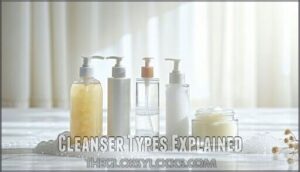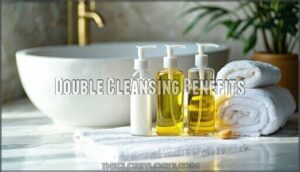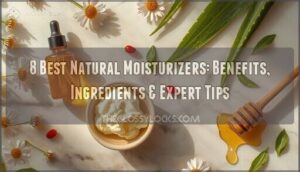This site is supported by our readers. We may earn a commission, at no cost to you, if you purchase through links.

Normal skin works well with gentle gel or cream cleansers, while dry skin needs hydrating formulas containing ceramides or hyaluronic acid.
Oily skin benefits from deeper-cleansing gels with salicylic acid, and sensitive skin requires fragrance-free options like micellar water.
Combination skin often needs different approaches for different facial areas.
Focus on ingredient lists rather than marketing claims—avoid harsh sulfates that strip natural oils and choose gentle formulations that clean without over-drying.
The perfect cleanser leaves your skin balanced and ready for moisturizer, not tight or irritated.
Table Of Contents
- Key Takeaways
- Identifying Skin Type
- Choosing Right Cleanser
- Cleanser Types Explained
- Key Ingredients Matter
- Cleansing Tips Importance
- Double Cleansing Benefits
- Final Cleanser Selection
- Frequently Asked Questions (FAQs)
- How do I choose the best cleanser for my skin type?
- How do I choose a good cleanser?
- Which cleanser is best for your skin type?
- How do I choose a good face cleanser?
- What is the difference between a cleanser and a wash?
- What are the different types of cleansers?
- How to know what type of cleanser to use?
- What cleanser is suitable for all skin types?
- How do you choose the best cleanser for your skin type?
- How do I determine my skin type?
- Conclusion
Key Takeaways
- Identify your skin type first – You’ll need to observe how your face feels throughout the day, checking for oiliness, dryness, tightness, or sensitivity to choose the right formula for your specific needs.
- Match cleanser types to your skin’s needs – You should use gel cleansers for oily skin, cream formulas for dry skin, foaming cleansers for combination skin, and gentle micellar water for sensitive skin.
- Focus on ingredients over marketing claims – You’ll get better results by reading ingredient lists and avoiding harsh sulfates while looking for beneficial ingredients like ceramides for dry skin or salicylic acid for oily skin.
- Test new products and adjust seasonally – You should patch test any new cleanser for 48 hours and switch formulas as needed, since your skin’s requirements change with seasons and environmental factors.
Identifying Skin Type
Understanding your skin type is the foundation of effective skincare and the first step toward selecting the perfect cleanser.
You can identify your skin type by observing how your face feels and looks throughout the day, particularly noting areas of oiliness, dryness, or sensitivity.
Characteristics of Normal Skin
When you have normal skin, you’ve hit the skincare jackpot.
Your skin maintains balanced sebum production without excess oiliness or dryness.
You’ll notice smooth texture with minimal concerns like breakouts or irritation.
Healthy hydration levels keep your complexion comfortable throughout the day.
Rare sensitivity means most products work well for your skin type, making cleanser selection straightforward and stress-free.
Signs of Dry Skin
Dry skin leaves telltale signs you can’t miss. You’ll feel skin tightness after washing your face, like your skin’s been stretched too tight.
Flaky patches appear, especially around your nose and forehead. Itchiness becomes your constant companion, particularly in winter months.
Your complexion loses its glow, developing dullness that makeup can’t fix. Fine lines seem more pronounced due to lack of skin hydration.
These symptoms signal your skin moisture barrier needs help, making a gentle cleanser for dry skin essential, to restore your skin’s natural glow and alleviate dry skin.
Traits of Oily Skin
Oily skin produces excess sebum, creating that telltale shiny appearance across your face.
This overproduction leads to enlarged pores, frequent breakouts, and persistent shine that returns shortly after cleansing.
Your skin feels slick to the touch and often struggles with pore congestion.
Three key traits identify oily skin:
- Persistent shine – Your face looks glossy within hours of washing, especially in the T-zone area
- Visible pores – Enlarged pores appear more prominent due to excess oil production and debris buildup
- Frequent breakouts – Blackheads, whiteheads, and acne form regularly as sebum mixes with dead skin cells
Combination Skin Features
Combination skin creates a unique puzzle – your T-zone produces excess oil while your cheeks feel tight and dry.
You’ll notice larger pore size around your nose and forehead, where product absorption happens quickly.
Meanwhile, your cheek dryness requires different care than your skin oily T-zone areas.
This skin type cleanser challenge intensifies with seasonal changes, making facial cleanser selection vital for balanced results.
Sensitive Skin Indicators
Reactions like stinging sensation and burning reactions signal skin sensitivity that requires special attention.
Your skin might react to fragrances, sulfates, or harsh ingredients with immediate discomfort. Sensitive skin cleanser selection becomes essential when you experience these warning signs:
- Redness triggers appear after using new products
- Skin irritation develops from environmental factors
- Itchiness causes discomfort during or after cleansing
- Product sensitivity creates burning or stinging reactions
- Skin redness persists even with gentle face cleanser use
Choosing Right Cleanser
Now that you’ve identified your skin type, selecting the right cleanser becomes straightforward when you match your specific needs to the appropriate formula.
The key is understanding how different cleanser types interact with your skin’s unique characteristics to maintain its natural balance without causing irritation or excessive dryness, which is crucial for complete concepts like skin care.
Benefits Of Renewable Energy
Just as finding the right skin cleanser means knowing your skin type, choosing renewable energy helps the planet and our wallets.
Environmental impact drops, public health improves, and job creation rises—much like a sensitive skin cleanser calming irritation.
Energy security grows, and economic growth follows, creating a win-win situation that keeps your skin and the world balanced and thriving, ensuring economic growth.
Challenges In Implementation
While choosing the right cleanser seems straightforward, you’ll face several implementation challenges.
Cost considerations often limit access to dermatologist recommended cleanser options, with prices ranging dramatically.
Formulation challenges affect product stability, making ingredient sourcing difficult for sensitive skin formulas.
Consumer adherence drops when skin care routines don’t match individual skin type needs or address specific skin concerns effectively, which can be a significant implementation challenge.
Global Policy Differences
Around the world, regulatory frameworks for skin care products vary dramatically, creating a complex landscape for cleanser selection.
The EU bans over 1,300 ingredients while the US restricts only 11, reflecting different cultural norms and ethical considerations.
These enforcement mechanisms impact which skin type cleanser formulations reach your local shelves, affecting both economic impacts and safety standards for various skin cleanser types.
Cleanser Types Explained
You’ll find five main cleanser types, each designed to match specific skin needs and concerns. Understanding these formulations helps you select the most effective option for your unique skin type.
Gel Facial Cleansers for Oily Skin
Gel cleansers work perfectly for oily skin by removing excess sebum without over-drying.
The perfect gel cleanser melts away excess oil while keeping your skin balanced and happy.
These lightweight formulas deliver deep cleaning while maintaining your skin’s natural balance.
For a gel cleanser oily is a great option.
Here’s what makes gel cleansers effective for managing skin oiliness:
- Oil Control – Gel cleansers target excess oil production without triggering rebound oiliness
- Ingredient Focus – Look for salicylic acid, niacinamide, or tea tree in your acne cleanser
- Application Tips – Use lukewarm water and gentle circular motions for best practices
Choose noncomedogenic cleansers to prevent pore-clogging while achieving maximum gel benefits.
Lotion and Cream Facial Cleansers for Dry Skin
Cream and lotion cleansers offer gentle hydration for dry skin without stripping natural oils.
These moisturizing formulas contain ceramides and hyaluronic acid to restore skin barrier function while cleansing.
| Cream Cleanser Benefits | Key Features |
|---|---|
| Hydrating Formula | Contains glycerin and ceramides |
| Gentle Cleansing | Won’t over-strip natural oils |
| Barrier Protection | Maintains skin’s moisture barrier |
| Soothing Texture | Rich, creamy consistency |
| Irritation Prevention | Free from harsh sulfates |
Apply with damp hands using circular motions, then rinse thoroughly with lukewarm water.
Many users find lotion cleansers effective for dry skin.
Foaming Cleansers for Combination Skin
Foaming face washes work well for combination skin because they provide T-zone balance without over-drying cheek areas.
These cleansers offer gentle exfoliation while maintaining proper hydration levels, making them an ideal skin type cleanser.
When selecting a foaming cleanser for combination skin, look for ingredient compatibility that addresses your Tzone’s oily concerns without compromising moisture elsewhere, which is crucial for achieving proper hydration.
Micellar Water for Sensitive Skin
Micellar water works like a magnet for sensitive skin, using micelle technology to attract impurities without harsh rubbing.
This gentle makeup removal method provides redness reduction and hydration benefits while ensuring minimal irritation.
You’ll avoid skin reactivity since micellar water requires no rinsing, making it perfect for gentle cleansing when your skin needs extra care and skin irritation avoidance.
Many brands offer sensitive skin options for this gentle cleanser.
Makeup Removing Cleansing Cloths for All Skin Types
Cleansing cloths offer convenience when you’re traveling or need quick makeup removal across all skin types.
These pre-moistened face wipes contain gentle surfactants and hydrating ingredients like glycerin, making them suitable for sensitive skin while effectively removing waterproof formulas.
Choose cloths with biodegradable materials for reduced environmental impact, and always follow proper disposal methods to minimize skin irritation from residue.
Key Ingredients Matter
Understanding which ingredients work best for your skin type transforms cleanser selection from guesswork into science.
The right active ingredients can address your specific concerns while maintaining your skin’s natural balance and health.
Key Ingredients for Dry Skin
Your dry skin needs a cleanser for dry skin that delivers Humectant Benefits through ingredients like glycerin and hyaluronic acid.
These hydrating cleanser components provide Glycerin Hydration by attracting moisture, while Ceramide Power restores your skin barrier.
Oil Cleansing with gentle formulas maintains natural oils, and it is crucial to focus on Avoiding Irritants like sulfates and alcohol for maximum comfort.
Balancing Ingredients for Oily Skin
Several ingredients work together to manage your oily skin cleanser effectively.
Oil control begins with sebum regulation through targeted compounds that address excess production without over-drying your complexion.
Key balancing ingredients include:
- Salicylic acid – penetrates pores for gentle exfoliation and pore minimization
- Kaolin clay – absorbs skin oil while maintaining hydration balance
- Niacinamide – reduces shine and controls sebaceous activity
- Benzoyl peroxide – targets bacteria while preventing rebound oiliness.
To further enhance the formula, consider incorporating antioxidants like vitamin C for added protection.
Soothing Ingredients for Sensitive Skin
When caring for sensitive skin, gentle ingredients act as your skin’s best allies.
Colloidal oatmeal reduces redness by 78% while providing antiinflammatory benefits that calm irritation effectively.
Aloe vera boosts hydration by 25%, delivering powerful skin soothing properties your complexion craves.
Ceramide power restores barrier function, reducing moisture loss substantially.
Choose hypoallergenic options and fragrance-free formulas to minimize reactions and protect sensitive skin from unnecessary triggers, utilizing gentle ingredients.
Exfoliating Ingredients for Combination Skin
When addressing combination skin, exfoliating cleansers with hydroxy acids help balance oily and dry zones effectively.
These actives target different concerns across your face without over-drying sensitive areas.
- AHA benefits: Glycolic and lactic acids smooth skin texture and appear in 43% of combination skin formulas
- BHA effectiveness: Salicylic acid penetrates pores, reducing blackheads by 22% when combined with other acids
- Enzyme cleansers: Papaya and pineapple enzymes provide gentler skin exfoliation for sensitive combination areas
Avoiding Harsh Ingredients for All Skin Types
Certain ingredients can irritate all skin types, causing redness, dryness, or breakouts.
Alcohol-based cleansers strip natural oils, while sulfates create excessive foam that disrupts your skin’s pH balance.
Fragrances and essential oils trigger sensitivity reactions.
Choose sulfate-free, fragrance-free cleansers with gentle alternatives like ceramides or glycerin.
Research cleanser ingredients before purchasing to guarantee barrier protection and sensitivity reduction for your specific skin type.
Cleansing Tips Importance
You need to follow the right cleansing tips because using the wrong cleanser can leave your skin feeling dry, oily, or irritated.
Understanding how and when to cleanse helps you keep your skin balanced and healthy, no matter your skin type.
Recommended Cleansing Frequency
Your skin type determines your ideal cleansing frequency.
Most people benefit from morning cleansing and evening cleansing as part of their daily face cleanser routine. Oily skin types may need twice-daily washing, while dry or sensitive skin often requires only evening cleansing.
Over-cleansing risks stripping natural oils, causing irritation and increased oil production. Post-workout wash helps remove sweat and bacteria that can clog pores.
Selecting the right cleanser can be enhanced by following an ultimate skincare routine.
How to Choose a Cleanser for Your Skin Type
When choosing the best face wash, your skin type needs determine everything.
Oily skin thrives with gel cleansers containing salicylic acid, while dry skin requires cream formulas with ceramides.
Budget considerations shouldn’t compromise quality—dermatologist recommended cleansers often provide better value.
Consider ingredient sensitivities and specific skin conditions when selecting your daily face cleanser for desirable results.
The Importance of Moisturizing After Cleansing
After cleansing, your skin needs immediate hydration to maintain its moisture balance.
Cleansing removes dirt but can strip natural oils, leading to skin dryness and compromised barrier function.
Moisturizing within minutes helps with barrier repair, reduces skin sensitivity, and improves product absorption.
This simple step prevents skin dehydration and supports long-term health, allowing your skin to benefit from improved product absorption.
Your skin will thank you.
How to Use a Cleanser for Optimal Results
Follow proper application technique for effective skin cleansing results.
Use lukewarm water temperature to avoid irritating your skin or stripping natural oils.
Apply cleanser with gentle circular motions, maintaining massage duration of 30-60 seconds to dissolve skin dirt and impurities.
Rinse thoroughly to remove all residue from your facial cleansing guide routine.
Pat dry with a clean towel to complete your skincare routine and ensure you have followed the guide for effective skin cleansing.
The Benefits of Double Cleansing
Beyond simply removing surface dirt, double cleansing with oil cleansers followed by water-based formulas offers deeper cleanse benefits.
This method excels at makeup removal while dissolving skin impurities that single cleansers miss.
The first step breaks down stubborn products without compromising your skin barrier, while the second cleanser addresses specific concerns.
This approach enhances product absorption in your routine afterward.
Double Cleansing Benefits
Double cleansing offers enhanced benefits when you tailor the method to your specific skin type and concerns.
This two-step approach guarantees thorough removal of impurities while maintaining your skin’s natural balance and health.
Double Cleansing for Oily Skin
Double cleansing transforms oily skin by reducing surface sebum up to 40%.
Start with light oil cleansers containing grapeseed to dissolve makeup and excess oils without pore-clogging.
Your second cleanse focus should target remaining impurities with salicylic acid gel cleansers, delivering 25% less post-cleansing oiliness.
This product layering approach provides superior pore congestion relief and makeup removal efficacy for acne-prone skin.
Double Cleansing for Dry Skin
Your dry skin craves gentle care through double cleansing.
Start with a cleansing oil containing squalane or jojoba to dissolve makeup without stripping your skin barrier.
Follow with a fragrance-free cream cleanser packed with ceramides and hyaluronic acid.
This method increases hydration by 20% while reducing tightness and flakiness by 30% compared to single cleansing.
Double Cleansing for Combination Skin
Combination skin requires strategic product layering to address both oily T-zone and dry areas effectively.
Your first cleanse should use an oil cleanser to remove makeup and daily buildup.
This step prevents over-cleansing dry cheeks while preparing skin for deeper cleaning.
Here’s your ideal double cleansing approach:
- Oil cleanser – Dissolves makeup without stripping normal cheeks or dry forehead areas
- Cream cleanser – Provides balancing hydration while addressing T-zone focus needs
- Gentle application – Massage lightly to avoid irritating different skin zones
This method works perfectly for skin combination types, ensuring each area gets appropriate care without disrupting your skin’s natural balance.
Double Cleansing for Sensitive Skin
Sensitive skin requires extra care when double cleansing. Start with gentle oils like sweet almond or jojoba to remove makeup without triggering skin inflammation.
These provide barrier protection while dissolving impurities. Follow with a fragrance-free cleanser containing soothing ingredients like colloidal oatmeal.
This technique refinement prevents redness through careful product selection, supporting your skin barrier while achieving thorough cleansing. Consider a minimalist skincare routine to avoid product overload and support a healthy skin barrier.
How to Double Cleanse for Optimal Results
Start with your oil cleanser first to dissolve makeup and sunscreen effectively.
Follow with a second cleanser type like foam cleanser or cleansing balms based on your skin needs.
Use gentle massage techniques with lukewarm water temperature, and practice double cleanse frequency of once daily in the evening for ideal skin makeup removal without stripping natural skin oils, using this method as part of your daily routine.
Final Cleanser Selection
You’ve learned about different cleanser types and how they work with your skin type, but making the final selection requires careful consideration of several factors.
Now it’s time to put that knowledge into practice by reading labels properly, testing new products safely, and adapting your routine as your skin’s needs change throughout the year, which involves careful consideration.
How to Read Cleanser Labels
Reading cleanser labels correctly helps you make informed choices. Ingredient lists appear in order of concentration, with the highest amounts listed first.
Understanding percentages isn’t always possible since companies aren’t required to disclose exact amounts. Look for fragrance-free claims if you have sensitive skin, as fragrance-free products reduce irritation risk.
Check expiration dates to confirm product effectiveness. Decoding claims like pH-balanced means the product matches your skin’s natural acidity level.
Avoid SLS if you experience dryness. Dermatologist-recommended labels indicate professional approval for safety and effectiveness.
How to Patch Test a New Cleanser
Testing a new cleanser prevents unwanted reactions before full skincare integration. Apply your potential dermatologist recommended cleanser or fragrance-free cleanser to a small patch test area first.
- Testing Location: Choose inner wrist or behind ear
- Application Frequency: Apply twice daily for 48 hours
- Reaction Time: Wait full 48 hours before evaluating
- Reading Results: Check for redness, itching, or irritation
Stop immediately if skin sensitive reactions occur during testing; consider a fragrance-free cleanser option to minimize irritation.
How to Adjust Your Cleanser Based on Seasonal Changes
Your skin’s needs shift with the seasons, requiring cleanser adjustments to maintain balance.
Winter dryness calls for cream-based cleansers with hydrating ingredients, while summer oiliness benefits from gel formulas.
Humidity effects can intensify these seasonal changes, making adjustment routine planning important for healthy skin.
| Season | Cleanser Adjustment |
|---|---|
| Winter | Switch to cream cleansers with ceramides and hyaluronic acid |
| Summer | Use gel cleansers with salicylic acid for oil control |
| Transition | Gradually introduce new formulas over 1-2 weeks |
How to Combine Cleansers for Optimal Results
Combining different facial cleansers can maximize your skincare benefits when done thoughtfully.
Layering Cleansers works well with Targeted Cleansing strategies. Your AM/PM Routine might include gel cleanser mornings and cream cleansers evenings.
Skin Cycling allows rotating oilbased cleansers with cleansing creams weekly for Addressing Concerns effectively.
- Morning clarity meets evening comfort – Start fresh, end nourished
- Your skin deserves personalized attention – Not one-size-fits-all solutions
- Weekly rotation prevents skincare boredom – Keep your routine exciting
- Strategic combinations yield better results – Smart pairing beats random mixing
How to Maintain a Consistent Skincare Routine
Successful habit formation starts with choosing products that match your skin type and lifestyle factors.
Morning cleansing becomes automatic when you establish a consistent product order. Track your skin’s response to seasonal adjustments and modify your daily cleansing routine accordingly.
| Time Frame | Routine Elements | Progress Tracking |
|---|---|---|
| Week 1-2 | Basic cleanser selection | Note skin reactions |
| Week 3-4 | Add morning cleansing habit | Monitor oil/dryness changes |
| Month 2-3 | Include seasonal adjustments | Track improvement patterns |
| Month 4-6 | Perfect product order timing | Document what works best |
| Ongoing | Maintain skincare tips consistency | Regular skin type assessment |
Frequently Asked Questions (FAQs)
How do I choose the best cleanser for my skin type?
Identify your skin type first—normal, oily, dry, combination, or sensitive. Match cleansers to your needs: gel for oily skin, cream for dry skin, gentle formulas for sensitive types.
How do I choose a good cleanser?
Think you’re destined for cleanser chaos?
Start by identifying if you’re oily, dry, combination, or sensitive.
Match gel cleansers to oily skin, cream formulas to dry skin, and gentle options to sensitive types.
Which cleanser is best for your skin type?
Choose cleansers based on your skin’s needs: gel or foaming for oily skin, cream or lotion for dry skin, gentle formulas for sensitive skin, and balanced options for combination skin.
How do I choose a good face cleanser?
First, determine your skin type by observing how it feels and looks throughout the day.
Match your cleanser to your skin’s needs: gel for oily skin, cream for dry skin, foaming for combination skin.
What is the difference between a cleanser and a wash?
The terms "cleanser" and "wash" are virtually interchangeable in skincare. Both refer to products that remove dirt, oil, and impurities from your face, though "cleanser" sounds more professional.
What are the different types of cleansers?
Cleansers come in several main types: gel cleansers provide deep cleaning for oily skin, cream cleansers offer hydration for dry skin.
Foaming cleansers create lather for combination skin, oil cleansers dissolve makeup effectively.
Micellar water gently removes impurities, and these various types of cleansers, including gel cleansers and micellar water, help address different skin needs.
How to know what type of cleanser to use?
Just like finding the perfect jeans requires knowing your measurements, selecting cleanser starts with identifying your skin type through simple observation.
Check if you’re oily, dry, combination, or sensitive by examining shine, tightness, and reactions to products.
What cleanser is suitable for all skin types?
Micellar water stands as your universal option, using gentle micelles to cleanse without harsh ingredients. It’s particularly ideal for sensitive skin while working effectively across all skin types.
How do you choose the best cleanser for your skin type?
Determine your skin type first by observing oil production, dryness, and sensitivity. Match cleansers accordingly: gel for oily skin, cream for dry skin, gentle formulas for sensitive skin.
How do I determine my skin type?
Your skin’s like a mirror reflecting your inner balance—observe how it feels and looks throughout the day.
Check for oiliness, dryness, tightness, or sensitivity after cleansing to identify your type.
Conclusion
Finding your perfect cleanser is like discovering the right key for a lock—it should open the door to healthy, balanced skin effortlessly.
Understanding how to choose the right cleanser for your skin type transforms your daily routine from guesswork into targeted care. You’ll know you’ve found your match when your skin feels clean but comfortable, never tight or irritated.
Remember that consistency matters more than expensive products. Start with gentle formulations, patch test new options, and adjust seasonally as your skin’s needs change, which is a key part of achieving healthy, balanced skin.
















